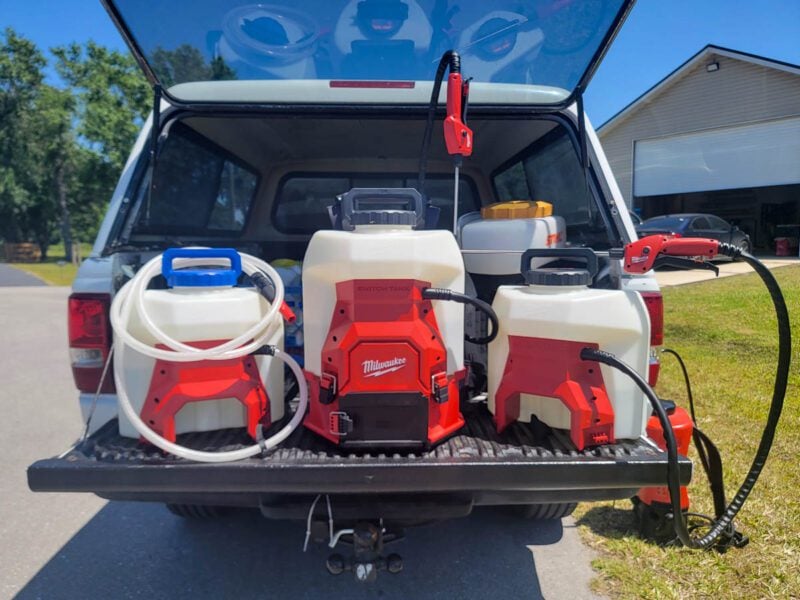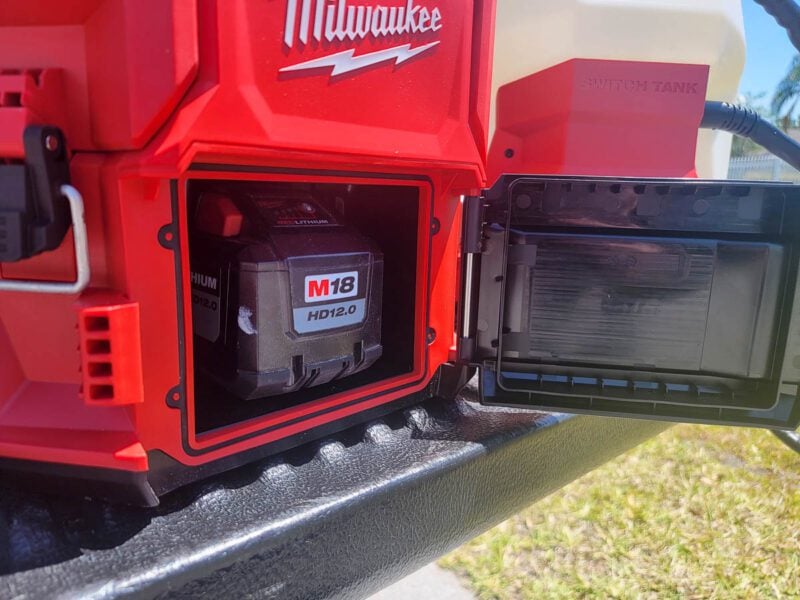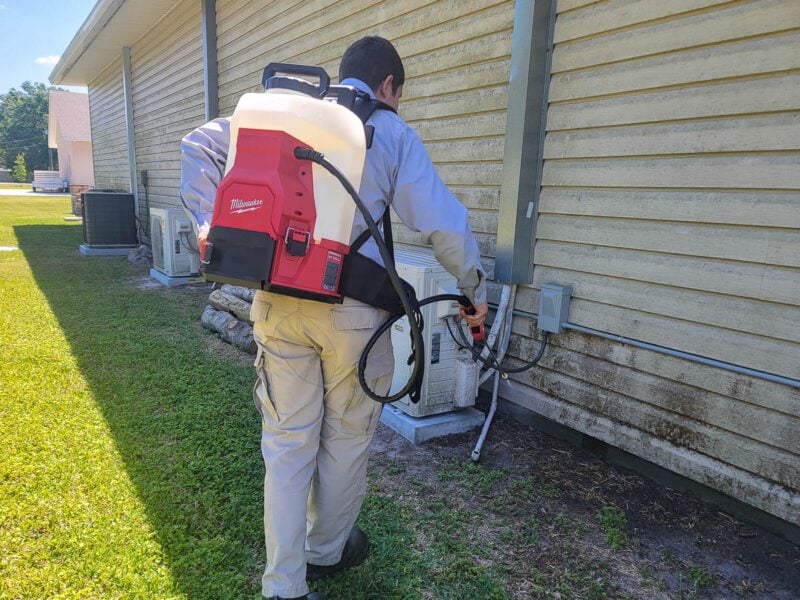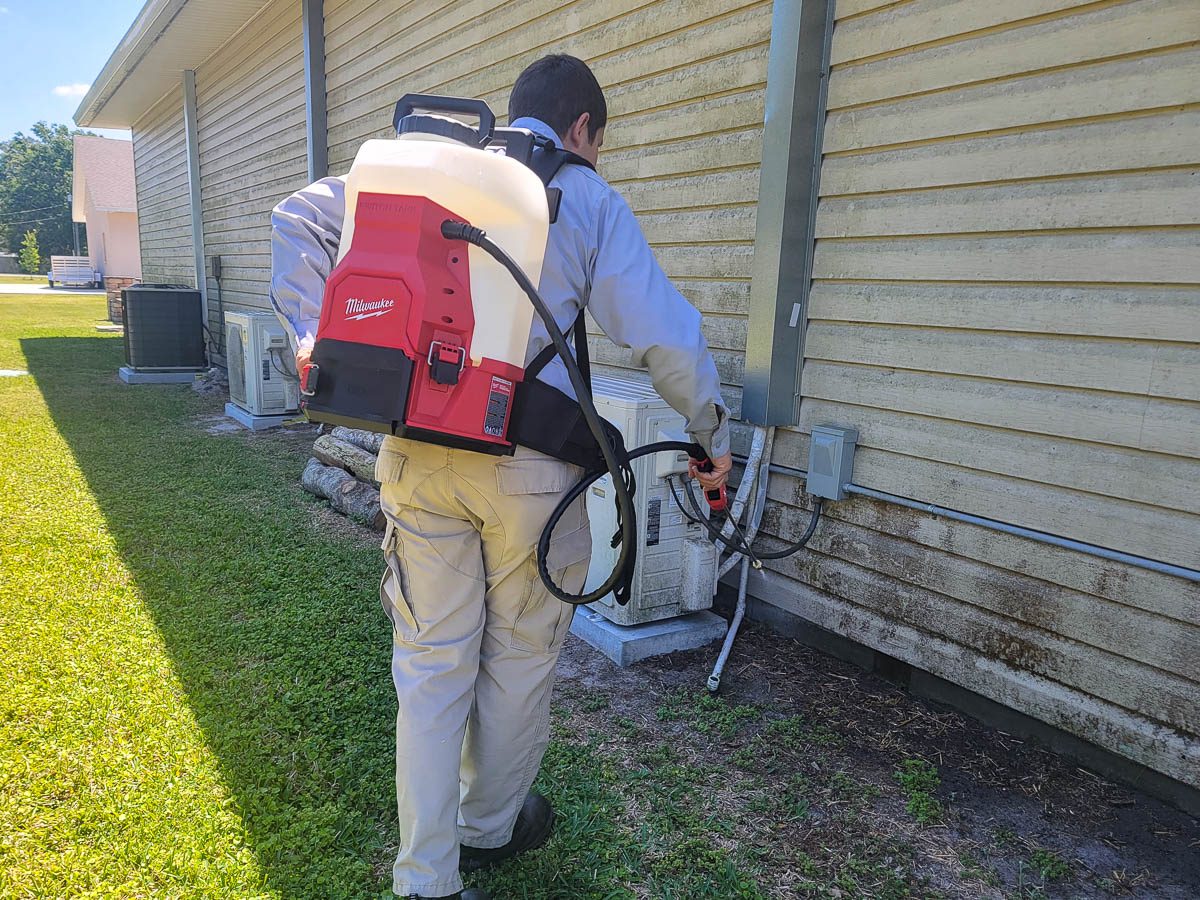Save Time On Application Jobs With the Milwaukee M18 Switch Tank Sprayer
A few years back, we got our hands on the first-generation Milwaukee M18 Switch Tank backpack sprayer (2820) for review. Right off the bat, the innovative multi-tank design piqued our interest and changed our perspective on what a battery-powered sprayer can do. Now, we’ve got our hands on the next-generation Switch Tank sprayer (3019) to see what it has to offer for busy Pros.
More often than not, we test most of the tools we review here at our shop. But in this case, I teamed up with my long-time friend Jonathan Stephens, owner of Revolution Pest Services here in Central Florida, to get the perspective of a real-world working Pro. He used the Milwaukee 3019 as his primary sprayer for several weeks, and got back to me with his observations.
Pros
- Excellent flow rate
- Long runtime
- Easy tank swaps
- Durable metal wand
- Easy to operate
- Comfortable ergonomics
Cons
- No significant drawbacks
Milwaukee M18 Switch Tank Basics

What’s interesting about this system is the areas it covers—concrete construction, landscaping, and pest control. They all have legitimate uses, and this is an interesting way to use one power base to expand in both industries.
This is a two-part system. The power base is where your battery connects and the motor lives. The tank assemblies hold the pump, hose, accessories, and stores your liquid.
It may seem odd to separate the motor and pump, but that’s what gives Milwaukee the ability to get different flow rates for different applications. That kind of separation also means you can swap tanks without worrying about cross-contamination between chemicals or having to do a thorough rinse when you’re ready to switch chemicals.
The best part is that you’re looking at a battery-powered backpack sprayer, so you can leave your days of manual pumping in the rearview!
Milwaukee M18 Switch Tank Water Supply (3019-21WS)
For the construction side of things, the Switch Tank Water Supply system is primarily targeting concrete cutting and drilling. It gives you adjustable pressure between 20 and 60 PSI with 5 adjustment settings and a flow rate ranging from 0.13 to 1.26 GPM.
The tank has a dual diaphragm pump and a wide mouth with a strainer.
- Milwaukee 3019-21WS
- 20 – 60 PSI with 5 adjustment settings
- 0.13 – 1.26 GPM flow rate
- Up to 40 tanks per charge with a 3.0Ah battery
- 10′ hose with quick connect
- Water spray nozzle included
- 18.9 pounds with battery, power base, and tank
- 3-year power base warranty
- 1-year tank assembly warranty
- $499 ($199 tank only 49-16-19WS)
Milwaukee M18 Switch Tank Backpack Sprayer
The Switch Tank Pesticide Sprayer system has 5 adjustable pressure settings from 20 to 140 PSI with a maximum vertical spray distance of 24 feet. The lower flow rate is designed to give you more control for targeting small areas.
The tank has the same dual-diaphragm pump as the others, along with Viton seals in critical areas. It also features a wide opening, a strainer, and a removable measuring cup.
- Milwaukee 3019-21PS
- 20 – 140 PSI with 5 adjustment settings
- 0.10 – 0.52 GPM flow rate
- 24′ vertical spray distance
- Up to 27 tanks per charge with a 3.0Ah battery
- Viton seals on critical areas
- 4′ hose with sprayer handle and metal wand
- Lock-off/on mechanism on sprayer handle
- Small diameter adjustable nozzle and fan nozzle included
- 18.9 pounds with battery, power base, and tank
- 3-year power base warranty
- 1-year tank assembly warranty
- $499 ($199 tank only 49-16-19PS or $399 bare tool 3019-20PS)
Using the Milwaukee M18 Backpack Sprayer

We’re primarily using the pesticide sprayer for our Switch Tank fun and the majority of our impressions are based on its use. The water supply is where delivery changes significantly. We haven’t yet had the chance to use it in that capacity.
Flow Rate
As I mentioned earlier, the separation between the powered base and tanks allows Milwaukee to customize the flow rate for specific applications. This means you don’t have to contend with a generic, one-size-fits-all solution.
| Mode | 3019-21WS | 3019-21PS |
|---|---|---|
| 1 | 0.13 GPM | 0.10 GPM |
| 2 | 0.30 GPM | 0.20 GPM |
| 3 | 0.52 GPM | 0.32 GPM |
| 4 | 0.77 GPM | 0.41 GPM |
| 5 | 1.26 GPM | 0.52 GPM |
The water supply tank puts out a much higher flow rate in order to manage dust and keep equipment cool, while the pump sprayer flows much slower allowing you to conserve product and cover more area.

Adjusting the flow is easy with a dial on the side. We really like that Milwaukee utilizes a large knob that’s easy to reach and turn, even while wearing gloves. With that said, it takes just a couple of minutes to get used to the power and flow rate adjustments if you’re coming from other sprayer brands.
The pump sprayer has a 24-foot vertical range, eliminating the need for additional wand extensions and ladders. The system easily reaches the soffits of taller residential buildings and quickly and easily covers large ground areas.
Runtime

Milwaukee’s previous Switch Tank sprayers put up some great runtime numbers; however, the 3019 boasts some incredible numbers! The water supply gives you up to 40 tanks per charge, while the backpack sprayer provides up to 27 tanks per charge, both using a 3.0Ah battery.
It’s worth noting that the sprayer base is compatible with all Milwaukee M18 batteries, even the monster HD12.0Ah battery! So if you need more runtime, just throw in a larger battery and you’re good to go.
Switching Tanks

This would be an incomplete Milwaukee M18 Switch Tank review if we didn’t actually talk about switching the tanks! It’s a pretty simple process. A pair of clips on the front secure the tank. Once those are loose, the tank just lifts up and off. Two downward-facing plastic hooks on the back of the tanks lock into the backpack harness for added security.

Once you fill the tank or swap tanks, the system may need to prime—something it does automatically, but it only takes a few seconds. After the pump is primed, you’re ready to get to work.
Comfort

Right out of the gate, Jonathan was very impressed by the build quality. He noted that it felt much more sturdy than many of the battery-powered sprayers he used in the past.
The shoulder and waist straps are very comfortable and easy to adjust on the fly. There is plenty of adjustment if you prefer the tank to ride higher or lower, and the padding on the backpack helps mitigate any discomfort while you work.
He did mention that the tag ends on the straps are a little long, but this is to accommodate a variety of body types. If they’re too long for you, all you need to do is trim them to your desired length and burn the ends to prevent fraying.
Ease of Use

As far as backpack sprayers go, Jonathan has run the gamut. He’s used manual pump backpack sprayers, gas-powered models from Stihl, and battery-powered models from Birchmeier, Ryobi, and Ridgid. He said the 3019 is by far the most user-friendly sprayer he’s ever had.
The ability to seamlessly swap from tank to tank, its impressive flow rate, and long runtime are just some of the top reasons why Jonathan fell in love with this system.
“I ran over 20 gallons of pesticide through this sprayer on one of my recent jobs, and the battery level didn’t drop a single bar!“
-Jonathan
Moreover, the integrated mixing cup saved him time during his prep stages, and the lid features a positive stop to prevent over-tightening, which has led to damaged seals and lost product in the past.
It wasn’t all bacon and roses, though. He did mention that the wand was a little front-heavy, which resulted in a few accidental trigger pulls. It’s not a huge deal if you’re spraying pesticides, but it could have bigger consequences if you’re spraying a herbicide, like RoundUp. Once you get used to the balance, it becomes second nature to use, though.
Milwaukee M18 Backpack Sprayer Design Notes
Ergonomics

Manual backpack sprayers typically have a dry weight ranging from 7 to 12 pounds, depending on their capacity. The Milwaukee 3019 weighs around 19 pounds when empty, but that number will obviously increase once you fill the 4-gallon tank.
Despite the weight, the harness holds the tank close to your back. It does a nice job of balancing the weight and gives you plenty of adjustability. I didn’t have any issues getting a good fit for my 6-foot frame.
The shoulder straps feature a generous amount of padding that provides some extra comfort, and the padded hip straps help to shift some of the weight off your shoulders. There is some padding on the back rest, but we do wish there was a little more down towards the bottom to help cushion your lower back as you walk. It’s a minor detail, but I can see some discomfort building over the course of a long day in the field.
One major benefit of this system is how easily it comes apart for storage. Because you can disconnect the tanks from the base, you can store them upright as you travel between jobs without fear of the whole sprayer toppling over. This is especially handy when extra storage space is at a premium.
Wand Storage

The most obvious place to store the wand is in the center of the tank handle. You also get a side storage position against the frame handle with a point directly below it to hold the tip.
Those are great, but it takes some practice to put the wand back in either location while wearing the Milwaukee Switch Tank. If you look closely at the hip strap on your right, an elastic loop lets you run the wand through it like a holster. This works well when you have a lot of distance to cover and want to free up your hands.
Wand Construction

The wand is often a point of concern. You can bend or break them, and the cheap ones have a tendency to leak. While it’s definitely possible to break the ones Milwaukee provides, they seem pretty stout. Milwaukee utilizes a stainless steel tube rather than cheaper plastic alternatives so it’s less likely to get damaged on the job or during transport. If it does get damaged, replacements are available.

Looking down at the grip, you have a large 4-finger trigger, and they even include a lock-on and a lock-off on the handle. One note we received from our pest control Pro, Jonathan, was that the grip angle takes a little time to get used to, but it certainly isn’t a dealbreaker for him.
The Bottom Line
Overall, I think Milwaukee made some meaningful improvements with the next-gen M18 SwitchTank backpack sprayer. The longer runtime and increased flow rates alone make them a compelling option for busy Pros, and the upgraded connection points make it so much easier to swap out tanks.
For Jonathan, this Milwaukee 3019 grants him the ability to do more without the hassles of a traditional sprayer. The Switch Tank design allows him to seamlessly switch between chemicals without needing to flush the tank and lines, and the availability of Milwaukee batteries adds an extra layer of convenience should he want a spare on hand.
There’s no denying that this sprayer is geared towards the Pro market, but I also believe it’s a great option if you take a hands-on approach to your lawn and pest care. Granted, the price tag may be a hurdle for some folks. If that’s the case, or you just don’t need the 4-gallon capacity, the Milwaukee M12 Handheld Sprayer might be a better option. However, if you’re on the hunt for a reliable battery-powered backpack sprayer, the Milwaukee M18 3019 is a pretty safe bet.



